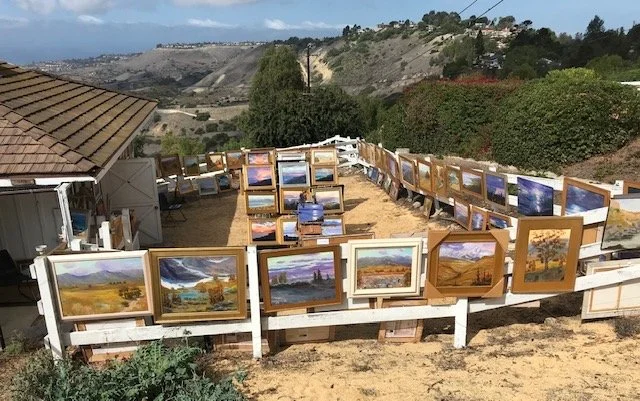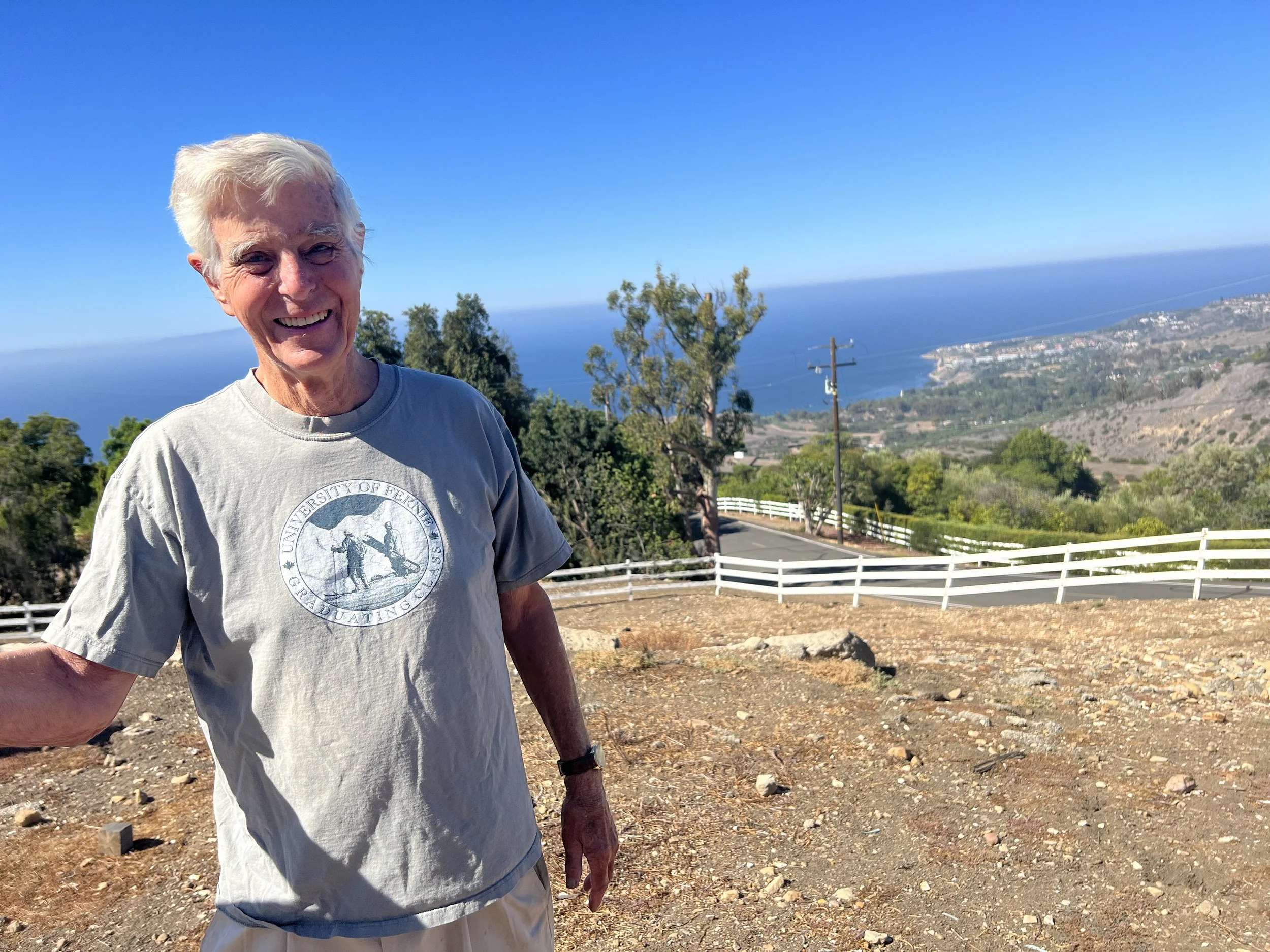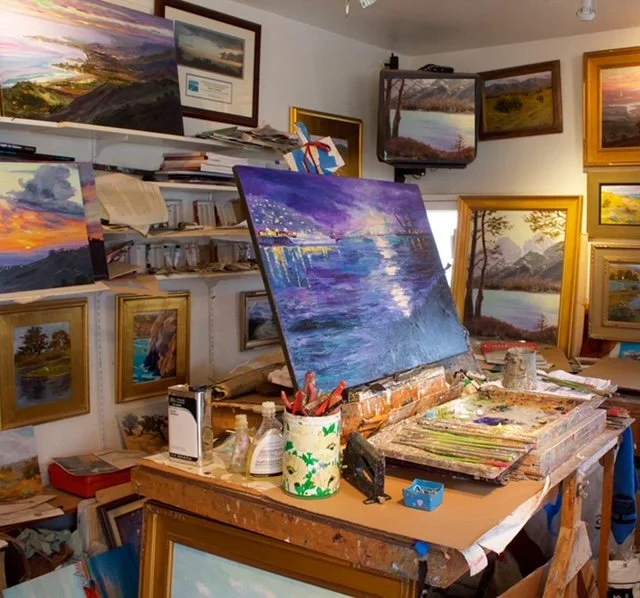Don Crocker: From Successful Lawyer to Plein Air Artist By Kari H. Sayers
Tall and straight with a head full of hair, Don Crocker, a 50 -year resident of Rolling Hills where he was mayor twice, and a long-time member of the City Council and the Community Association, belies his status as an octogenarian. A graduate of Stanford University Law School, he practiced law for fifteen years and ended up in a law firm in downtown Los Angeles called Halstead and Crocker. “I was the Crocker,” Don said in a recent interview. “We did tax and real estate.” From law, he segued into crisis management. “We managed billions of dollars in contracts and got involved in seriously troubled assets, bank insolvency, bankruptcy.” He soon became a manager but his training and experience as a lawyer was invaluable, he said. “We prided ourselves on not getting involved in a lot of litigation and instead working with the borrowers if we could. I became good at negotiating compromises.”
At age 65, he officially retired but prefers the term “switching careers. “I didn’t want to retire. I’d heard horror stories about how the wives couldn’t wait to get you out of the house and get a career,” he said. And so, he became a professional artist. He learned from the book Drawing and the Right Side of the Brain by Betty Edwards that the right side of his brain, the artistic side, was as well developed as his left side, the analytical side. Although he hadn’t been involved in any art activities since he was in elementary school, except buying and collecting paintings, he decided to take workshops. For the past 22 years, he’s been a professional plein-air painter.
A relative introduced him to the Palos Verdes Art Center. “I took my first class in stained glass and then other classes in painting. “The Art Center has been valuable to my life, and I had the chance to be president and chairman of the board.”
Many of his sales have been through the California Art Club. His most expensive painting went for $5000. Two of his paintings this year went for $3,500 each. However, galleries take 50% and that includes the frames. The materials are also expensive. “There are only a few artists who are able to make a living as an artist,” Don said. “And during COVID even those artists suffered enormously.”
Don was born and raised in Pasadena, a 3rd generation Californian. His father was a lawyer and his mother a homemaker. He grew up with an identical twin brother and another younger brother who both died young. “And I met my wife in 1st grade in a little school in South Pasadena,” Don recalled. “But her father was a naval officer, and they moved away.” The two reconnected as adults. “I didn’t remember her, but she remembered me and my twin brother.” They have now been married for 64 years and raised three children who produced eleven grandchildren, only one of whom is artistically gifted. “She graduated with a degree in engineering from Stanford,” Don said. “Both she and her husband have engineering jobs. . . . and she does creative welding for staircases in fancy houses in Montecito.”
Although he didn’t plan a career as an artist when he bought his beautiful property in 1972, it’s ideal for plein-air painting with its sweeping view of the coastline and the glittering Pacific Ocean below. His favorite time to paint is early in the morning, before 10 am, and in the evening: “Several hours before sunset, through sunset, when the fog is coming in, and into the night with the lights from Golden Cove. I love to paint lights.”
His favorite painters are the early painters of the High Sierras such as Albert Bierstadt and Thomas Payne. “Painters who studied in Europe made the Sierras look like the Alps,” Don said. “I have done many paintings of the Sierras. I take my gear with me, and I’m able to paint or take photographs.”
Another favorite painter is Granville Redmond who painted oaks, poppies and lupins. “I paint trees all the time,” Don said. “And in the spring when there are wildflowers, I paint them. They’re very popular. I sell a lot of flower paintings”
From Russian painter Ovanes Berberian, Don took a seminar in painting sunsets and nocturnals, also very popular.
Don prefers to paint in oil, although he has also tried acrylic. “But acrylics dry so fast that you can’t blend, even though I keep spraying. It takes a lot of sensitive blending to get beautiful colors. Also, I paint outside, but I don’t finish and want to go back to my studio and keep working.”
However, he uses acrylics for underpainting. “I like to paint on color. I use lilac to for cold paintings and a reddish-orange color for warm painting,” he explained. He paints night and foggy paintings on silver. “When I paint the reflection of the moon on water, I leave some silver in.”
Today, Don also gives workshops to adults and children through the PV Art Center. Once a year for three years, he went into all the intermediate schools in Palos Verdes. “When the bell rang, about 30 kids plus aides to help the disabled students came in. They had ten minutes to eat snacks. Then, I’d passed out art materials and taught the subject matter. When they finished, we had to clean up before the next class came in. It was very challenging. I enjoy teaching, but it takes a terrific amount of time, and I like to paint and be involved in other activities.”
His least favorite part of being an artist is when none of his works are accepted in a show, but that is made up for the feeling he has when someone buys his paintings.
Don will be one of the four hosts of this year’s self-guided home studio tour on October 15 and 16, 2022. Tickets are $20 for adults, valid for the two-day event and available at www.taspv.com or at the PV Art Center on the corner of Crenshaw and Crestridge Road.in RPV. Children under 18 are free.
Kari H. Sayers BIO
With a BA in English and an MA in linguistics from California State University, Long Beach, Kari Sayers went with her husband to Saudi Arabia, where she first worked as a music teacher at Riyadh International Community School and then as a journalist for the English newspapers the Saudi Gazette and the Arab News as well as in-flight magazines. When she returned to Southern California, she taught literature, college composition, and English as a Second Language at Marymount California University in Rancho Palos Verdes, while freelancing as a theater, classical concert, and opera reviewer for local newspapers and magazines in the Los Angeles area.. In addition to authoring the novels Roses Where Thorns Grow, Under the Linden Tree, and the soon-to-be-released Justice for Lizzie, all published by Melange Books in Minnesota, she is the developer and editor of the anthology Views and Values, published by Cengage. Now widowed, Kari lives in the Los Angeles area.












